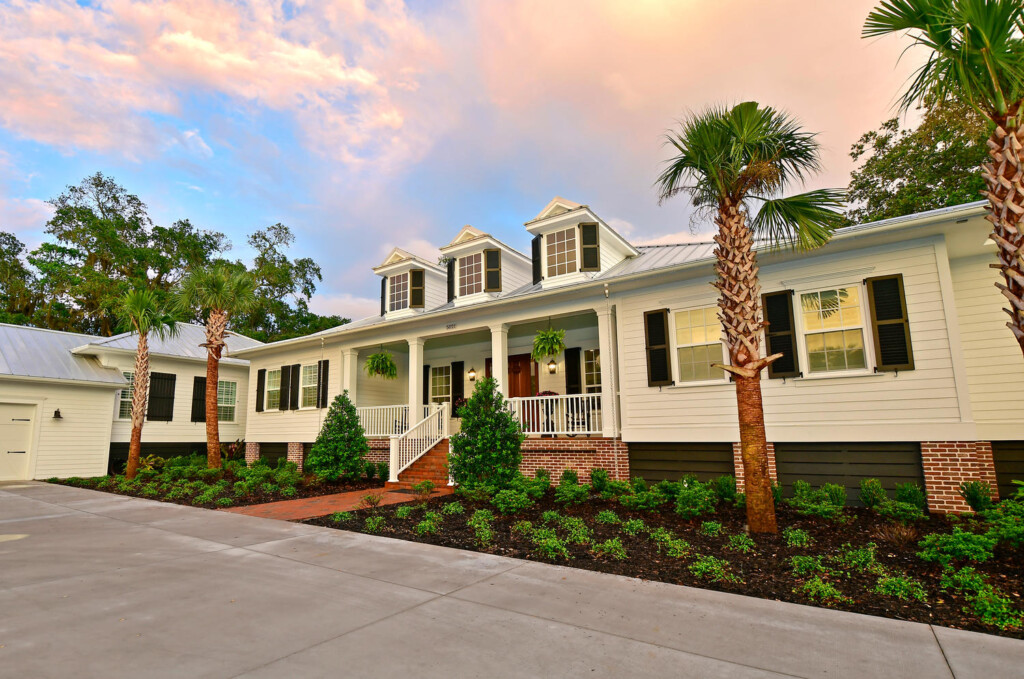From Tampa to Venice and across our Keys, the Gulf Coast region has many historic communities that showcase elegant homes from a bygone era – creating enclaves that celebrate our legacy and culture. As new residents move into these neighborhoods with the dream of building custom homes, it provides a unique architectural opportunity. This kind of project requires thoughtful planning to ensure that the design respects the character of the historic neighborhood while providing the functionality and aesthetics expected in a modern home.

Bruce Williams Homes has been building homes on the Gulf Coast for over 50 years – and we’ve collected some thoughts on how to approach your new custom home build.
- Respecting the Neighborhood’s Architectural Character: When designing a custom home in a historic area, the first step is understanding the neighborhood’s architectural style. Historic neighborhoods often have a specific character that reflects a particular time period, such as Victorian, Colonial Revival, Craftsman, or Mid-Century Modern. Identifying the dominant style in the neighborhood will guide your design decisions, helping to create a home that blends in with the surroundings rather than standing out in an incongruous way. Historic homes often have a certain rhythm or scale, so your design should match the height, width, and overall volume of surrounding houses. Avoid overly large or overpowering designs that might disrupt the street’s visual flow. Instead, focus on creating a home that feels like it belongs within the context of the neighborhood.
- Modernizing the Floor Plan and Amenities: While the exterior of your home should be designed with respect to the neighborhood’s history, the interior can reflect more modern needs and lifestyles. Traditional historic homes often feature segmented rooms with formal layouts, which can feel constricted in today’s living spaces. One way to modernize the design is by creating an open floor plan that promotes fluidity between spaces. Energy-efficient windows, better insulation, and smart home technologies are must-haves for today’s homes, and while these may not be visible from the outside, they can improve the home’s performance and reduce long-term costs. The key is to incorporate these features discreetly so they don’t interfere with the aesthetic you’re trying to preserve.Incorporating traditional details such as wainscoting or hardwood flooring will evoke the charm of older homes and can be updated by blending contemporary finishes.
- Landscaping to Complement the Historic Setting: The landscape surrounding your custom home is just as important as the building itself when it comes to fitting into a historic neighborhood. Many historic areas feature well-established gardens, mature trees, and historic street layouts. When planning your landscaping, consider using period-appropriate plants and design elements such as low fences, brick walkways, and shaded porches that evoke the look of older homes while still being practical and comfortable for modern living.A front porch can be a great addition that provides both curb appeal and a space to relax while connecting with the street, much like traditional homes did in the past. If your property allows, consider adding landscaped courtyards or formal gardens with traditional plantings, such as hydrangeas, boxwoods, or climbing roses, to add beauty and charm to your home’s exterior.
Historic Neighborhood Preservation Guidelines
Many historic neighborhoods are subject to specific zoning regulations and preservation guidelines to protect the area’s character. They may require a review process by a preservation board or similar authority, which ensures that new homes and renovations respect the architectural integrity of the area.
These regulations may govern exterior materials, window styles, or even the height and massing of your new home. Working with an established custom home builder from the area ensures that your new home will deliver on your vision while doing its part to preserve the authenticity of the neighborhood.
Call Bruce Williams Homes today to learn more about building a beautiful custom home in the Sarasota or Manatee area.
From Tampa to Venice and across our Keys, the Gulf Coast region has many historic communities that showcase elegant homes from a bygone era – creating enclaves that celebrate our legacy and culture. As new residents move into these neighborhoods with the dream of building custom homes, it provides a unique architectural opportunity. This kind of project requires thoughtful planning to ensure that the design respects the character of the historic neighborhood while providing the functionality and aesthetics expected in a modern home.

Bruce Williams Homes has been building homes on the Gulf Coast for over 50 years – and we’ve collected some thoughts on how to approach your new custom home build.
- Respecting the Neighborhood’s Architectural Character: When designing a custom home in a historic area, the first step is understanding the neighborhood’s architectural style. Historic neighborhoods often have a specific character that reflects a particular time period, such as Victorian, Colonial Revival, Craftsman, or Mid-Century Modern. Identifying the dominant style in the neighborhood will guide your design decisions, helping to create a home that blends in with the surroundings rather than standing out in an incongruous way. Historic homes often have a certain rhythm or scale, so your design should match the height, width, and overall volume of surrounding houses. Avoid overly large or overpowering designs that might disrupt the street’s visual flow. Instead, focus on creating a home that feels like it belongs within the context of the neighborhood.
- Modernizing the Floor Plan and Amenities: While the exterior of your home should be designed with respect to the neighborhood’s history, the interior can reflect more modern needs and lifestyles. Traditional historic homes often feature segmented rooms with formal layouts, which can feel constricted in today’s living spaces. One way to modernize the design is by creating an open floor plan that promotes fluidity between spaces. Energy-efficient windows, better insulation, and smart home technologies are must-haves for today’s homes, and while these may not be visible from the outside, they can improve the home’s performance and reduce long-term costs. The key is to incorporate these features discreetly so they don’t interfere with the aesthetic you’re trying to preserve.Incorporating traditional details such as wainscoting or hardwood flooring will evoke the charm of older homes and can be updated by blending contemporary finishes.
- Landscaping to Complement the Historic Setting: The landscape surrounding your custom home is just as important as the building itself when it comes to fitting into a historic neighborhood. Many historic areas feature well-established gardens, mature trees, and historic street layouts. When planning your landscaping, consider using period-appropriate plants and design elements such as low fences, brick walkways, and shaded porches that evoke the look of older homes while still being practical and comfortable for modern living.A front porch can be a great addition that provides both curb appeal and a space to relax while connecting with the street, much like traditional homes did in the past. If your property allows, consider adding landscaped courtyards or formal gardens with traditional plantings, such as hydrangeas, boxwoods, or climbing roses, to add beauty and charm to your home’s exterior.
Historic Neighborhood Preservation Guidelines
Many historic neighborhoods are subject to specific zoning regulations and preservation guidelines to protect the area’s character. They may require a review process by a preservation board or similar authority, which ensures that new homes and renovations respect the architectural integrity of the area.
These regulations may govern exterior materials, window styles, or even the height and massing of your new home. Working with an established custom home builder from the area ensures that your new home will deliver on your vision while doing its part to preserve the authenticity of the neighborhood.
Call Bruce Williams Homes today to learn more about building a beautiful custom home in the Sarasota or Manatee area.






